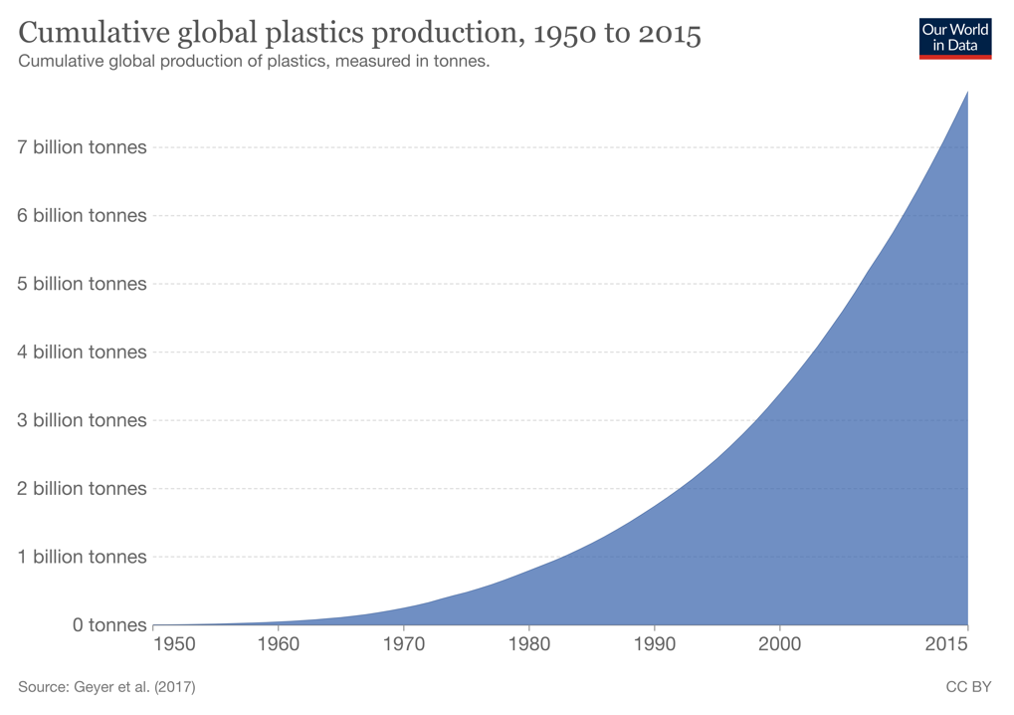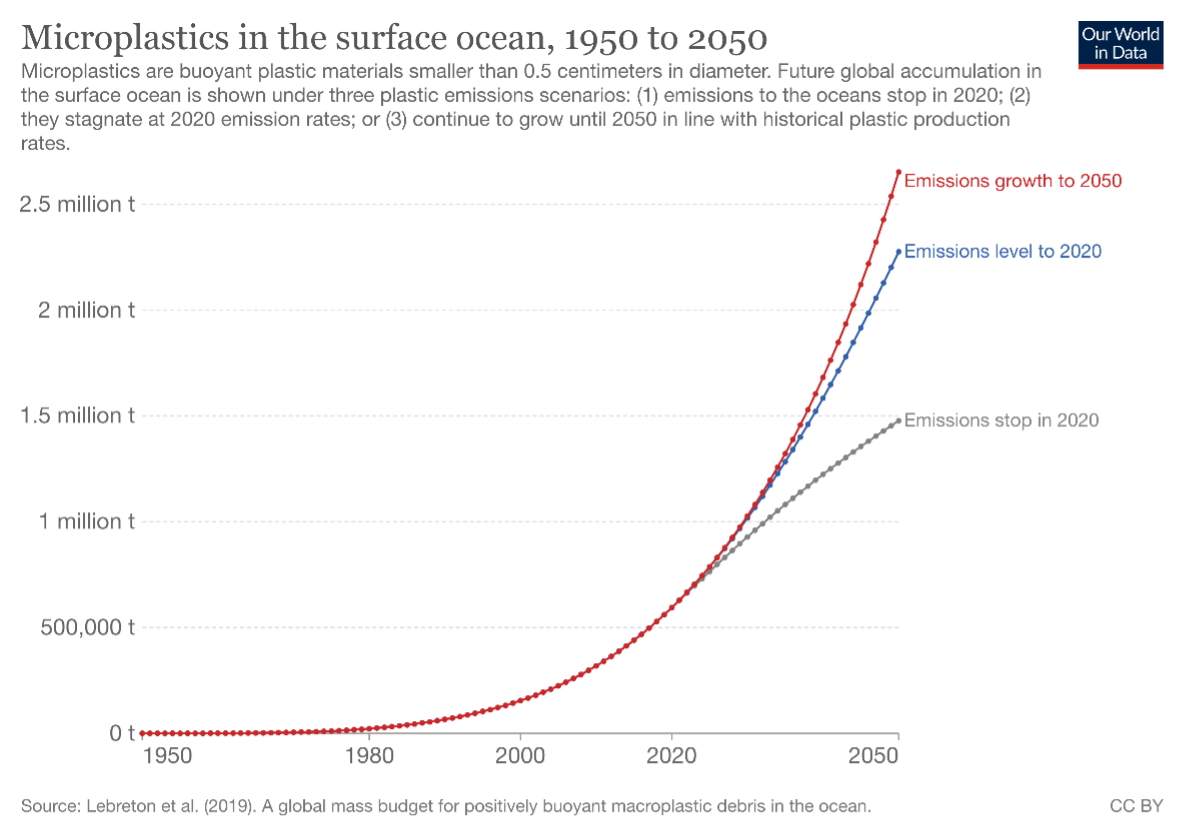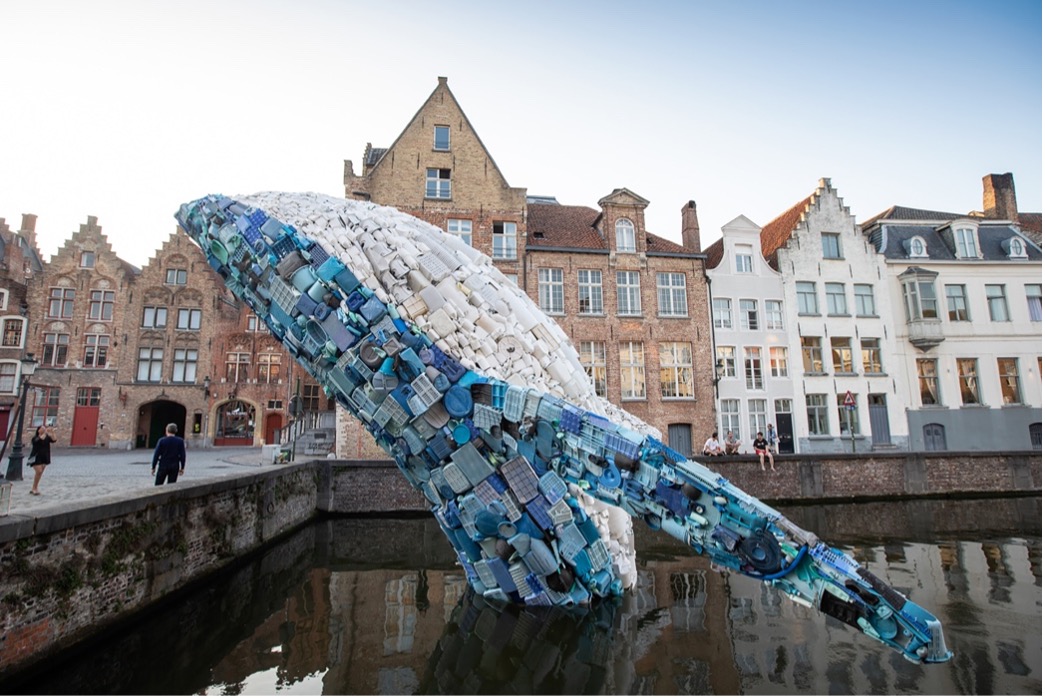In focus: plastics
Posted: 27 January 2022

A sculpture in Bruges, Belgium made from 4.5 tons of plastic waste collected from the Atlantic and Pacific oceans.[1]
When was the last time you bought something that was packaged with plastic? Chances are that it was the last time you bought anything, period. In this day and age, it is almost impossible to walk into any grocery store, order any product, or buy any take-away food without receiving something that has been packaged with plastic. Whether it be the lid of the drink you got from McDonalds, the eco-labelled cucumbers from the grocery store, or the sweater you ordered from your favourite clothing brand, plastic packaging is practically everywhere today. Since the 1950’s, the world has produced a total amount of approximately 7.8 billion tons of plastic, meaning more than 1 tonne of plastic for each person alive today [2].

The benefits
While these numbers might seem surprising, the reason why plastic is so common around the world is more straight forward. It’s very cheap, easy to shape with unfortunately fantastic properties. Plastics are made from a type of polymers, i.e., materials consisting of long chains of molecules with unique characteristics, that depending on the molecules can be either flexible or tough, or everything in between [3]. Due to the nature of the molecules and the polymers, they can be moulded and shaped into nearly any shape or form to fit the need. Plastics can be made to have high heat insulation or even conduct electricity. The low density of plastics makes them light weight and therefore cheap to transport and handle, they are highly resistant to corrosion and durable in nearly any environment and can be transparent or coloured. As if this was not enough, plastics can be altered with numerous modifications to meet even more design and use demands [4]. Another argument is that keeps plastics offer protection against grease, moisture and oxygen which is important for foodstuff and other sensitive product. relevant is the ability to preserve foods and therefore reduce food waste. Glass and metal packaging can break and expose foods to bacterial attacks, while complex multi-layered plastics can increase the shelf life of foods from a few days to weeks. Around one third of the food produced around the world goes to waste, so increased shelf life is an important factor keeping this fraction of waste from increasing [5]. Then there is of course the question of money. For example, the price of producing one plastic bag is about 1 cent, compared to a paper bag costing 5 cents. A compostable bag costs around 8 to 10 cents to produce [6].
The problems
Looking at the above, the reason why plastic is so common does not come as much of a surprise. However, many of these benefits are pushed on by plastic producing mega-corporations, so it is important to take them with a grain pinch of salt. Firstly, most low-cost, and conventional plastic polymers are made of natural gas or crude oil. If we can turn toswich over to more bio-based alternative plastic sources, we can give fossil fuels one less reason to remain in use. These so-called bioplastics can be biodegradable and made from renewable polymers like starch, meaning that we can rely less on fossil fuels and more on for example agricultural waste, significantly reducing our carbon footprint. Learn more about these innovative materials here [link to the new materials blog?].
Furthermore, the practicality of plastics has of course made it extremely widespread in all types of uses, especially in packaging. This comes with a catch, as more plastics in rotation means more plastic that needs to be disposed of somewhere. In 2016, the Ellen MacArthur Foundation, a UK registered charity working to promote a Circular Economy, published the well renowned report called The New Plastics Economy. Including suggesting numerous ways for how to improve the plastics industry in the future, the report highlighted the scale of plastic pollution. In 2013, 78 million metric tonnes of plastic were produced, 40% of this went to landfills and 32% was leaked into the environment. 14% was collected for recyclinged, and a shockingly low fraction of 2% was actually closed-loop recycled, meaning the plastic was recycled into a similar quality level, with other fractions being recycled into lower quality applications [7]. Plastic pollution causes harm to animal life and ecosystems. I n the same Ellen MacArthur report, it was stated that we will have more plastics in the ocean than fish by 2050. Most plastics that are released in the environment can take hundreds of years to decompose, or they can be designed to degrade quicker, but in both cases they will leave behind microplastics. These microplastics are nearly impossible to collect, and they have been found everywhere… and we mean EVERYWHERE. Recent studies have shown that microplastics can be found in the air we breathe, the water we drink, and even the food we eat. Most of the microplastics are found in drinking water, both tap and bottled, but also in for example beer, salt, shellfish, and even fruits and vegetables. The World Wildlife Foundation found that on average a person consumes about the equivalent of a credit card each week [8]. While the exact effects on human and animal life are still being researched, plastic in our bodies cannot be good for us.

While the effect on our health might still be uncertain, the effect on our wallets is clear. Due to the wastage of plastic and the resulting amount of material that is not recycled, the New Plastics Economy also highlighted that around 80-120 million USD are lost each year [9]. By investing in more plastic recycling, and simply putting more effort to correctly dispose of our plastic waste we can save money, and the environment.
Circulate’s stance
Here at Circulate, we understand how beneficial plastic is. As a packaging option, the benefits are clear, but that is just not good enough for us. If you ask us, the negative environmental impacts outweigh the practicality. That is why we limit the types of products on our platform to better alternatives and always stay away from conventional plastics.
[1] https://ourworldindata.org/plastic-pollution
[2] https://www.livescience.com/60682-polymers.html
[3] https://www.plasticseurope.org/en/about-plastics/what-are-plastics
[4] https://cen.acs.org/articles/94/i41/cost-plastic-packaging.html
[5] https://www.bmt.com/what-is-the-real-cost-of-paper-vs-plastic/
[6] Rethinking the future of plastics, 2016. The Ellen MacArthur Foundation
[8] [9] Rethinking the future of plastics, 2016. The Ellen MacArthur Foundation